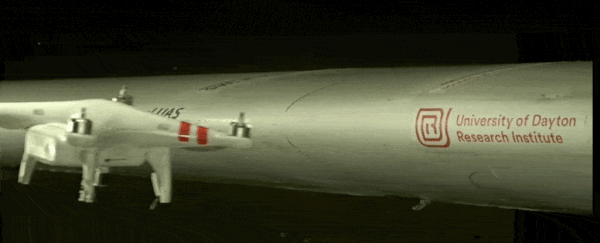When you're high above the clouds at cruising altitude in a giant passenger jet, probably the last thing on your mind is the threat of a mid-air collision with a drone.
But at take-off and landing, that danger isn't so distant. Last year, a drone did in fact collide with an in-flight US Army Black Hawk helicopter at Hoffman Island, New York. Nobody was hurt, but what if an impact like that happened with an aircraft travelling at much greater speed?
We've now got a scary vision of what that might look like, thanks to a team at the University of Dayton Research Institute (UDRI), who simulated the conditions of a mid-air collision between a drone and a commercial transport aircraft travelling at 383 kilometres per hour (238 mph).
Given it would be unfeasible and incredibly dangerous to test this with an actual flying aircraft, the researchers had to settle for using an air cannon, firing a DJI Phantom 2 quadcopter at the wing of a Mooney M20, a small four-seater aircraft:
While you might have expected the tiny drone to be obliterated on impact, the test shows the drone actually pierces the wing of the small plane. According to the researchers, it ended up damaging the main spar, a primary structural element of the wing.
"While the quadcopter broke apart, its energy and mass hung together to create significant damage to the wing," says mechanical engineer Kevin Poormon, who runs a team studying impact physics at UDRI.
Normally, the work involves simulating bird-strike testing of aircraft wings, windscreens, and engines, but the Black Hawk incident in New York indicates drone-strike testing is something else aviation authorities can't ignore.
"We've performed bird-strike testing for 40 years, and we've seen the kind of damage birds can do," Poormon says.
"Drones are similar in weight to some birds, and so we've watched with growing concern as reports of near collisions have increased."
While the Federal Aviation Administration (FAA) has created laws to regulate the recreational use of drones, Poormon says there is scant hard data about the extent of damage drone impacts with planes, with most of what we know coming from modelling, which actual collision tests sorely lacking.
In addition to their drone-strike test, the team ran a bird-strike simulation on a different part of the same wing for comparison purposes, using a similarly weighted 'bird' composed of gelatine.
"The bird did more apparent damage to the leading edge of the wing," Poormon says, "but the Phantom penetrated deeper into the wing and damaged the main spar, which the bird did not do."
Of course, we can't rush to conclusions from what's an early, work-in-progress means of testing these collisions. And it's important to note the current research – presented at the Unmanned Systems Academic Summit in August – hasn't yet been peer-reviewed.
Nonetheless, in a worst-case-scenario, spar damage could be the distinction between a damaged wing and a crashing plane.
"All the weight of the aircraft is suspended on the spars," Poormon told WIRED.
"If you damage the spar enough on that side, you would not, um, survive. The aircraft would crash."
For what it's worth, DJI, the manufacturer of the drone used in the testing, has responded to the publicity surrounding UDRI's collision video, publishing a lengthy take-down of the simulation's shortcomings.
Chiefly, DJI says the speeds involved are so high they usually wouldn't be possible at drone altitudes, but were deliberately maximised in the video to create a more spectacular "damaging scenario".
"In other words, it is virtually impossible for these two aircraft to encounter each other at the speed of your test," the company's vice-president of policy & legal affairs, Brendan M. Schulman explains.
"Given that kinetic energy, and therefore resulting damage, increases by the square of velocity, the arbitrary increase in your test velocity results in dramatically more damage."
Those are things we should definitely bear in mind while watching this video.
But we should also bear in mind that the increasing risk of mid-air drone collisions is something that can't be ignored.
As it happens, it was a DJI drone that crashed into that Black Hawk last year.
In that incident, the drone pilot intentionally flew his recreational drone beyond his visual line of sight to a distance of 4 kilometres (2.5 miles) away, even though he knew helicopters frequently flew in the area.
In fact, he wasn't even aware his non-returning drone had crashed, assuming it had malfunctioned and plummeted into the harbour.
As long as drone pilots do things like this, there can't be enough drone-strike testing, even if the simulations themselves need to keep being refined too.
The findings were presented at the Unmanned Systems Academic Summit in Dayton, Ohio in August.
